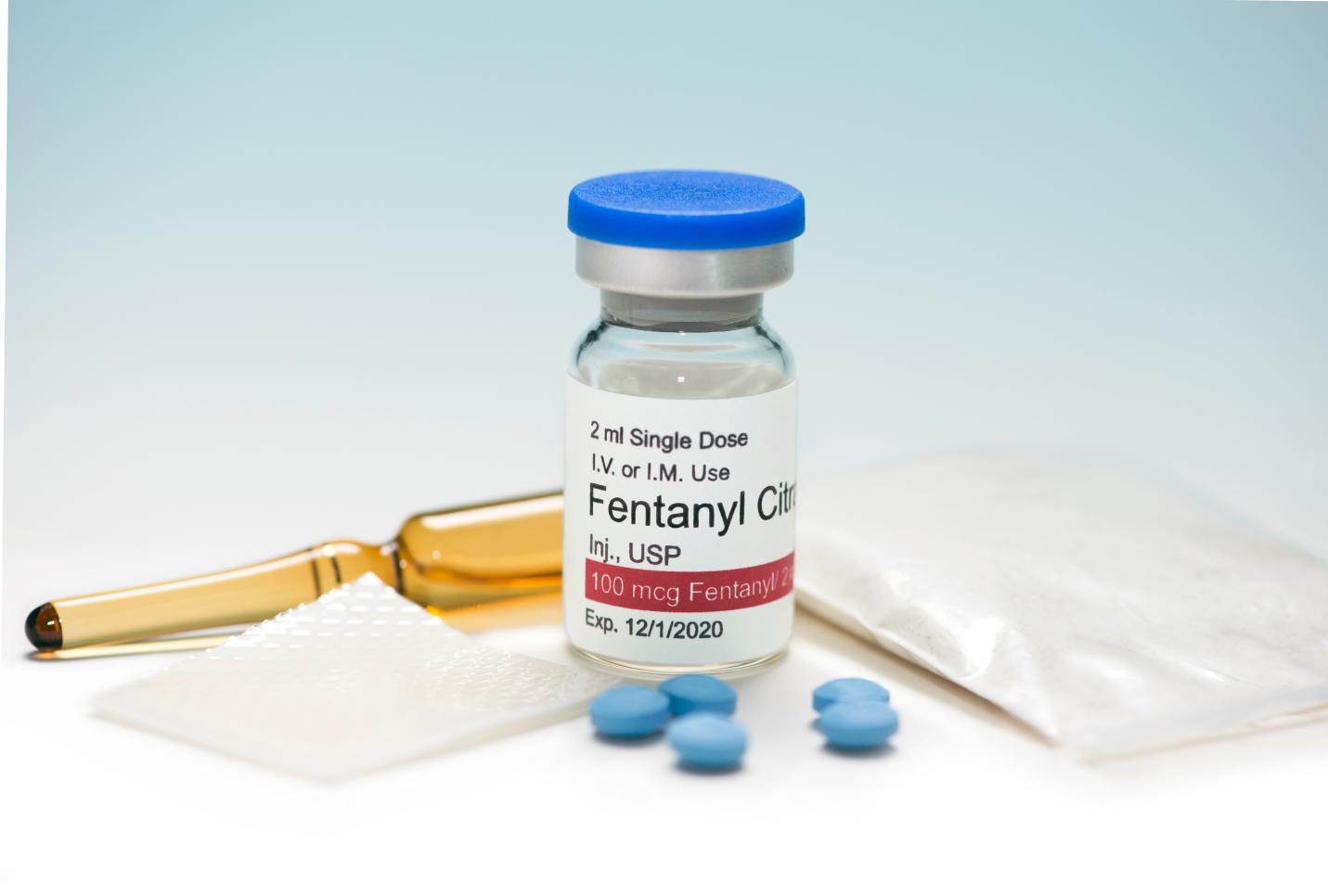Fentanyl is a powerful synthetic opioid at the center of the opioid crisis. With potency up to 50 times that of heroin, understanding its effects and dangers is critical. In this guide, we’ll delve into the key aspects of fentanyl — from its medical use and illicit misuse to its duration in the body, potential for overdose, and the life-saving role of Narcan.
More importantly, we’ll shine a light on the pathway to recovery, underscoring the reality that help is always available and recovery is possible.
What Is Fentanyl?
Fentanyl is a potent, synthetic opioid pain reliever. Its power is akin to morphine but is 100 times more potent. Fentanyl is frequently used in medical settings to relieve pain after surgeries or for those battling chronic pain who no longer find relief from other opioids.
It is prescribed in various forms, such as injections, patches, and even lozenges. However, fentanyl has also become a significant player in the opioid epidemic.
Its potency and highly addictive nature make it a target for illicit manufacturing and misuse, thereby contributing to the ongoing opioid crisis. Non-prescription fentanyl, often sold in powder form or mixed into other drugs like heroin or cocaine, can significantly increase the risk of overdose.
We understand that dealing with severe pain or navigating the path of a loved one’s pain management can be a challenging journey. In this light, it’s our aim to ensure you have the information you need on fentanyl.
This knowledge can empower you and your loved ones to recognize the signs of misuse or addiction and know when to seek help.
How Long Does Fentanyl Last in the Body?
When it comes to this powerful opioid, its impact and duration in your system can depend on several factors, including the method of use, individual metabolism, age, overall health status, and dosage.
When taken as prescribed by a healthcare provider, fentanyl can relieve pain within minutes. Transdermal patches, designed to release the drug slowly, can relieve pain for up to 72 hours. However, its half-life, or the time it takes for half the drug to leave the body, is typically around two to four hours.
In the case of illicit fentanyl, which can be mixed with other drugs, the effects can be unpredictable and potentially deadly. Overdose can occur rapidly, often within seconds to minutes after ingestion, due to fentanyl’s high potency.
How Long Is Fentanyl Detectable in the Body?
Fentanyl metabolites, or the products of the body breaking down the drug, can linger, much like echoes of the drug’s effects. These metabolites can be detected in urine for up to three days after use.
Hair tests can detect fentanyl for up to three months. However, it’s important to note that detection times can vary based on the individual’s metabolism, how much they used, and the type of test used.
Understanding how long fentanyl stays in the body and its effects is vital, but it is equally important to recognize signs of misuse or addiction. This can include drowsiness, confusion, sedation, trouble breathing, and decreased heart rate. If you or someone you know exhibits these symptoms after using fentanyl, immediately seeking medical attention is important.
How Does Fentanyl Impact the Body?
Fentanyl, with its exceptional potency, has a profound impact on various bodily systems. Its role as an opioid means it interacts primarily with the nervous system, but its influence reaches far beyond.
Let’s delve into a more detailed exploration of how fentanyl interacts with your body.
The Nervous System
At its core, fentanyl is designed to alter our perception of pain. It achieves this by interacting with the opioid receptors in our brain and spinal cord.
Once it attaches to these receptors, it effectively blocks pain signals from reaching the brain. This can provide powerful relief for individuals grappling with severe or chronic pain.
Additionally, this interaction triggers a release of dopamine, a neurotransmitter associated with feelings of pleasure and reward. This is why, along with pain relief, users may experience a sense of euphoria or intense happiness.
However, this action also presents a significant risk. Overuse or misuse of fentanyl can result in respiratory depression — a severe slowing or cessation of breathing. This occurs because opioid receptors in the brainstem, responsible for automatic processes like breathing, also respond to fentanyl.
The Digestive System
Fentanyl can impact the digestive system as well. Like other opioids, it tends to slow the movement of the intestines. This can lead to issues like constipation, nausea, and vomiting, particularly in long-term use or overconsumption.
The Cardiovascular System
Fentanyl’s influence extends to the cardiovascular system too. It may cause low blood pressure, slow heart rate, or even cause your blood vessels to dilate, leading to a feeling of lightheadedness or fainting.
The Dangers of Overconsumption and Long-Term Use
While fentanyl can feel like a lifeline for those in severe pain, its misuse can be perilous. Overconsumption can rapidly lead to overdose, given its potency.
Long-term use also has its risks. The body can develop a tolerance to fentanyl, requiring higher doses for the same effect and potentially leading to dependence and addiction. Over time, this can cause significant changes to the brain’s functionality, including problems with decision-making, memory, and emotional regulation.
Signs of a Fentanyl Overdose
Identifying the signs of a fentanyl overdose is crucial, whether you’re a user, a loved one, or even a passerby. An overdose may sometimes appear similar to a high, making it harder to recognize. But it’s always safer to err on the side of caution; if unsure, treat the situation as an overdose.
Signs of a fentanyl overdose may include:
- Extreme drowsiness or difficulty waking up
- Slowed or stopped breathing
- Pinpoint pupils
- Cold and clammy skin
- Blue lips and/or fingernails
- Loss of consciousness or unresponsiveness
The faster you recognize these signs, the quicker you can act, potentially saving a life.
What To Do If You Think Someone Is Overdosing on Fentanyl
If you suspect someone is overdosing on fentanyl, it’s essential to act swiftly and thoughtfully.
Here are the steps you should follow:
1. Call for Immediate Medical Attention:
Always start by calling 911. They can provide guidance and dispatch emergency medical assistance. Most states have Good Samaritan laws that protect the caller and the person overdosing from legal consequences.
2. Administer Naloxone (Narcan), If Available:
Narcan is a life-saving medication that can reverse the effects of opioid overdose. If you have it on hand, administer it as per the instructions. Narcan acts swiftly to bind to opioid receptors, effectively blocking the effects of fentanyl and reversing the overdose.
3. Try To Keep the Person Awake and Breathing
Engage the person in conversation, keep them moving if possible, and remind them to take breaths.
4. Lay the Person on Their Side
Laying the person on their side helps prevent potential choking if the person vomits.
5. Stay With the Person Until Emergency Assistance Arrives
Even after administering Narcan, it’s crucial to stay with the person. The effects of Narcan last for about 30 to 90 minutes, while fentanyl can last much longer, meaning a second overdose is possible.
Understanding and recognizing the signs of a fentanyl overdose, knowing the steps to take, and the role of Narcan can make a significant difference.
Seeking Treatment for a Fentanyl Addiction
Recognizing a struggle with fentanyl addiction is the first crucial step on the road to recovery. If you or a loved one are dealing with addiction, it’s important to understand that you’re not alone and help is available.
Treatment plans are not one-size-fits-all, and the approach that works best for you might involve a combination of therapy, medication, support groups, and lifestyle changes. At SOBA New Jersey, we believe that every person’s experience with addiction is unique.
That’s why we provide personalized treatment programs tailored to your specific needs and circumstances. Our evidence-based approach focuses on the symptoms of addiction and the underlying causes, giving you a comprehensive recovery plan.
We also recognize the significant role that community plays in the recovery process. Our team provides opportunities for you to connect with others on their path to recovery. In this supportive and understanding environment, shared experiences can provide comfort, reduce feelings of isolation, and offer valuable insights from others’ journeys.
The Bottom Line
Understanding fentanyl — its nature, its impact on the body, how long it lasts in the system, the potential for overdose, and the life-saving role of Narcan — is key to recognizing signs of misuse or addiction, ensuring timely intervention, and ultimately, safeguarding health and lives.
However, the most important takeaway should be that if you or a loved one are struggling with fentanyl addiction, you are not alone. Treatment and recovery are not only possible but are a path to a healthier, happier life.
We at SOBA New Jersey know firsthand that seeking support is not an admission of failure but a courageous step toward reclaiming control over your life. We are committed to providing personalized, comprehensive treatment as a trusted partner on your recovery journey. With our professional support, a strong recovery community, and your determination, recovery from fentanyl addiction is entirely possible.
No one should have to face this battle alone. At SOBA New Jersey, we’re with you every step of the way. Reach out today, and let us help you start your journey to recovery.
Sources:
Naloxone DrugFacts | National Institute on Drug Abuse (NIDA)





